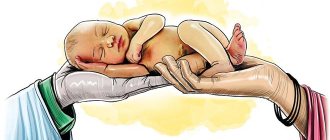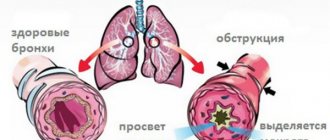First aid for drowning should occur very quickly, immediately after removing the victim from the water. In summer, you can save a person in 3-8 minutes, and in winter – 10-15 minutes. The colder the water, the longer the effectiveness of resuscitation for a drowned person remains. First aid for drowning of a child is always done 3-5 minutes longer, since children are more resistant to a decrease in the level of oxygen in the blood.
First aid measures for drowning are divided into pre-hospital (performed at the scene of the incident by people with or without medical education) and hospital (performed by resuscitators). Despite the restoration of breathing and cardiac activity, a patient with drowning must be hospitalized in a hospital.
=
=
Types of drowning
Doctors distinguish the following types of this condition:
- True.
It is also called wet, “blue”, primary. This is the most common type in which fluid penetrates the lungs and stomach and prevents breathing. A person fights for life for a long time, gradually choking. This is how children and those who cannot swim usually drown. A drowning person actively moves, holds his breath, tries to swim out, this leads to loss of consciousness and hypoxia in the brain. When an unconscious state occurs, liquid in large quantities fills the lungs and stomach, passes into the bloodstream, making the blood thin. It is because of the leakage of such blood through the vascular walls that the skin acquires a blue tint. There are three clinical periods. Initial - with him the victim was conscious, he was pulled out while he could still hold his breath. The rescued person's skin is bluish, noisy breathing and coughing attacks are heard, arterial hypertension and tachycardia are replaced by bradycardia, the abdomen is distended, vomiting of gastric juice and swallowed liquid is possible. The person recovers quickly after this, but some disorientation, weakness and cough may continue for a couple of days. Agonal - the drowning person is unconscious, there is a pulse, but weak and muffled, breathing is barely audible. The body is blue and cold, pink foam comes from the nose and mouth. Clinical death - with it there is no pulse or breathing, the person looks the same as during the agonal period, the pupils do not react to light, they are very dilated. - Asphyxial.
Known to be dry and "pale". This type occurs only in 5–20% of victims. The condition occurs due to the fact that the fluid irritates the upper respiratory tract and a spasm of the glottis occurs. Most often, this is preceded by alcohol intoxication, central nervous system depression, and impact with water. The initial period is usually not diagnosed; with agonal drowning, the pulse is confused and rare, false respiratory breathing is heard, and the transition to clinical death from agony lasts about 5–6 minutes. - Secondary.
Referred to as “death on the water.” Occurs during a heart attack, epileptic attack or other disorder accompanied by reflexive arrest of breathing and heart. A person is already in a state of clinical death, and only then does water enter the organs. The timing of death depends on the temperature, the nature of the water and the presence of impurities in it, and the general condition of the body. At the same time, resuscitation measures should be carried out before the victim has been brought to land, this way there will be a greater chance of success. - Syncope.
With it, the heart reflexively stops and breathing is interrupted due to cold water in the upper respiratory tract. In this case, clinical death or “ice shock” immediately occurs - the victim is not breathing, there is no pulse, the pupils are dilated and do not move, the skin is very pale. Most often it happens when you fall into an ice hole or remain in icy water for a long time.
What is drowning
The World Health Organization (WHO) defines drowning as respiratory distress caused by immersion or prolonged exposure to water. As a result, breathing problems and asphyxia may occur. If first aid to a drowning person is not provided on time, death occurs. How long can a person go without air? The brain can function for only 5-6 minutes during hypoxia, so it is necessary to act very quickly, without waiting for the ambulance team.
There are several reasons for this situation, but not all of them are accidental. Sometimes incorrect human behavior on the surface of the water leads to undesirable consequences. Key factors include:
- injuries from diving in shallow water, in unexplored places;
- alcohol intoxication;
- emergency situations (seizures, heart attack, diabetic or hypoglycemic coma, stroke);
- inability to swim;
- neglect of a child (when children drown);
- getting into whirlpools, storm.
How to pull a drowning victim to shore?
When a person is drowning in consciousness, it is important for the rescuer not only to pull him out, but also not to drown himself. There is no time to think about your actions and make decisions, weighing everything and thinking for a long time. If the victim is unconscious, minutes also count, therefore, to provide first aid for drowning, you need to pull the person ashore as soon as possible, following these rules:
- If a conscious drowning person is approached from behind and grabbed by the hair or neck, so that he does not reflexively grab onto the rescuer and pull him under the water.
- You need to move to the shore, trying to hold the head of the drowning person above the water.
- If the victim still clings on and tries to pull him under the water, he should dive, then he will open his hands on reflexes.
- If there is a suspicion of back injuries or a spinal fracture, it is recommended to pull it out using a special board or board.
- A person should be pulled out from under the water by the hand or hair.
Actions after first aid
Even if a person has regained consciousness, this does not mean that he does not need medical care. You should stay with the victim, call an ambulance or seek help from a doctor. It is worth knowing that when drowning in fresh water, death can occur even after a few hours (secondary drowning), so you should keep the situation under control. If you remain unconscious and without oxygen for a long time, the following problems may occur:
- disorders of the brain and internal organs;
- neuralgia;
- pneumonia;
- chemical imbalance in the body;
- permanent vegetative state.
To avoid complications, you should take care of your health as quickly as possible. A person rescued from drowning should take the following precautions:
- learn to swim;
- avoid swimming while intoxicated;
- do not go into too cold water;
- do not swim during a storm or in deep water;
- Don't walk on thin ice.
A life-threatening condition, which is characterized by the onset of asphyxia when fluid enters the lungs with subsequent swelling, is called drowning. In the absence of timely resuscitation measures, a person may die suddenly from acute respiratory failure. This should not be allowed, so it is useful for everyone to remember what pre-medical actions on the part of the rescuer include emergency assistance in case of drowning. Act immediately.
Providing first aid for drowning
Depending on the types of drowning, first aid may differ slightly, for example:
- True drowning.
After removing the drowned person from the pond, he must be turned face down so that the position of the head is lower than the pelvis. For a better effect, you can place the victim with his stomach on his knee. Then, the oral cavity should be properly cleaned of any foreign contents and mucous masses. Next, with a sharp movement, press on the very root of the tongue and when vomiting spasms begin, remove all the water from the stomach and respiratory organs. If there is no cough or vomiting, and breathing and pulse are inaudible, place the person on his back and begin resuscitation procedures. When signs of life appear, turn it face down again and remove the liquid. After this, warm up, calm down and wait for the ambulance to arrive. - With asphyxial “pale” drowning.
Move the victim to a comfortable, safe place and check the pulse in the area of the carotid artery, also raise the eyelids and determine whether there is a reaction to light. If there are signs of vital activity, place the victim in a warm place, change clothes and give him warm tea. If not, then immediately perform resuscitation procedures in the form of cardiac massage and artificial respiration. The same actions for syncopal drowning. - In case of “death on the water”,
it is important to start resuscitation as early as possible, if possible, even before arriving ashore. During transport, the rescuer must blow air into the nose or mouth. On the shore, if the examination shows fainting, we give ammonia and warm the victim. If everything is worse, but the pulse is present, but there is no breathing, then we clean the oral cavity, do artificial respiration, clear the stomach and lungs of fluid. If there are no pulse beats, we massage the heart.
Emergency resuscitation is carried out as follows:
- Place the victim on his back on a hard, flat surface.
- We tilt his head back so that his chin is pointing up.
- We hold our nose.
- We make two blows into the mouth, closing the nostrils with one hand. If the jaw is spasmed, inhale into the nose.
- We place one palm on the chest, the other across it, and on unbent arms, we press with rhythmic movements with the whole body with equal force 15 times every ten seconds.
- We tilt our head back again and blow air twice.
We continue to provide first aid for drowning without stopping until doctors arrive or until breathing and heartbeat are detected.
If a pulse appears and the person begins to breathe, we lay him on his side, cover him, and warm him up. You should definitely insist on a medical examination, even if the victim refuses, because you can be sure of complete safety only after five days and in the absence of any consequences during this time. For more information on first aid for drowning, see below:
First aid rules
The desire to help a drowning person does not always bring benefits. Misbehavior by a third party often only makes the problem worse. For this reason, first aid for drowning must be competent. What is the mechanism of PMP:
- After the person is removed from the water and covered with a blanket, symptoms of hypothermia (hypothermia) need to be checked.
- Call an ambulance.
- Avoid deformation of the spine or neck, do not cause damage.
- Secure the cervical spine with a rolled up towel.
- If the victim is not breathing, artificial respiration and cardiac massage should be started.
In case of true drowning
In approximately 70 percent of cases, water enters directly into the lungs, causing true or “wet” drowning. This can happen to a child or a person who cannot swim. First aid for drowning includes the following steps:
- palpation of the pulse, examination of the pupils;
- warming the victim;
- maintaining blood circulation (raising legs, bending the body);
- ventilation of the lungs using breathing apparatus;
- if the person is not breathing, artificial respiration must be performed.
With asphyxial drowning
Dry drowning is somewhat atypical. The water never reaches the lungs, but instead the vocal cords spasm. Death can occur due to hypoxia. How to provide first aid to a person in this case:
- perform cardiopulmonary resuscitation immediately;
- call an ambulance;
- when the victim came to his senses, warm him up.
Carrying out artificial respiration
Typically, artificial respiration begins with exhalation. If the chest rises, then everything is normal and the air is passing through; you can make several blows, pressing on the stomach after each blow to help the air escape.
It is necessary to carry out resuscitation until breathing and pulse are restored on their own or until undeniable signs of death appear, such as rigor or cadaveric spots. One of the most common mistakes when providing first aid is premature termination of resuscitation measures.
Usually, when performing artificial respiration, water is released from the respiratory tract, which got there during drowning. In such a situation, it is necessary to turn the victim’s head to the side so as to allow the water to flow out and continue resuscitation. If resuscitation is performed correctly, water will flow out of the lungs on its own, so squeezing it out or lifting the victim upside down makes no sense.
After the victim comes to his senses and breathing is restored, it is necessary to take him to the hospital, since deterioration of his condition after improvement is practically the norm for drowning. The victim should not be left unattended for a single minute, as swelling of the brain or lungs, respiratory and cardiac arrest can begin at any minute.
Types of drowning
The difficulties in providing emergency care lie in the fact that there are different types of drowning. Before indicating the sequence of assistance, it is necessary to analyze the causes and mechanisms of development of different types of drowning.
There are 3 types:
The true one is divided into drowning in fresh and sea water. It develops when water enters the lungs, most often while swimming. When extricating the victim, he often foams at the mouth. The most common type.
Asphyxial drowning occurs when ice or chlorinated water enters the trachea, which causes a reflex spasm of the vocal cords - laryngospasm. This is how people who swim poorly or are intoxicated usually drown.
Syncopal drowning is when, when falling from a height, upon contact with cold water, a reflex arrest of the heart and breathing occurs. Clinical death occurs with all its signs.
We can say that this is the most favorable type of drowning, since there is no damage to the lungs from water. In cold water, the period of clinical death can increase to 10-15 minutes. And children can spend about half an hour in clinical death.











